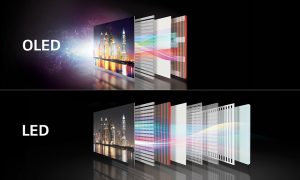OLED
Posted on May 29, 2017 by KVMGalore | 0 comments
OLED (organic light-emitting diode) is a light-emitting diode (LED) in which the emissive electroluminescent layer is a film of organic compound (containing carbon plus some other ingredients). This layer of organic semiconductor is situated between two electrodes behind the glass screen. When electrical current is applied to the conductors, a bright light is emitted.
 OLED technology is used to make displays and lighting.
OLED technology is used to make displays and lighting.
OLED acronym is typically used in reference to the highest-grade television sets on the market, in which each pixel in an OLED display is made of a material that glows when you jab it with electricity.
OLED panels emit their own light when an electric current is passed through, whereas cells in an LCD display require an external light source, like a giant backlight, for brightness.
Because OLEDs emit light (and do not require a backlight) they are thinner and more efficient than LCD displays (which do require a white backlight). OLED displays are not just thin and efficient - they can also be made flexible (even rollable) and transparent.
An OLED display works without a backlight; thus, it can display deep black levels and can be thinner and lighter than a liquid crystal display (LCD). In low ambient light conditions (such as a dark room), an OLED screen can achieve a higher contrast ratio than an LCD, regardless of whether the LCD uses cold cathode fluorescent lamps or an LED backlight.
A traditional LCD screen has a backlight (called a cold-cathode fluorescent light, or CCFL) which is uniform across the entire back of the screen.
An LED-LCD screen uses an array of LEDs as a backlight, which means that if a certain part of the screen is black then the LEDs behind that portion could be turned off to make it appear blacker. This is a better solution than a CCFL backlight, but it still has its problems. Since it's a light behind the LCD producing the illumination rather than the LCD layer itself, the illumination is not entirely in-sync with the pixel in front of it. The result is an effect called 'blooming', whereby LED light from bright portions of the image bleeds over into areas of blackness.
This is what separates OLEDs from LCD/LED displays. In an OLED display, the pixels themselves are the things producing the light, and so when they need to be black they are able to turn off completely, rather than relying on a backlight to turn off on their behalf.
The result is remarkably dark blacks in an image, and when you combine this with the brightness of the whites an OLED panel is able to produce you're left with a fantastically vibrant image.
In short: OLED truly is the next big thing in home entertainment and it's finally at a price where the average consumer can buy one their own. OLED televisions offer exceptional image quality (think blacker blacks and brighter whites), reduced power consumption and fast response time over traditional LED TVs, albeit at exceptionally high prices.





